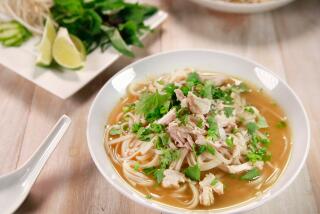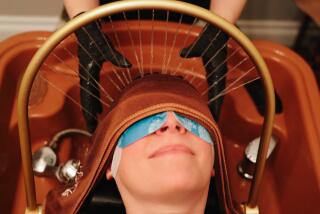The Cold War : Medicine: How to get well in a diverse L.A.: Take two Chinese herbs and call your acupuncturist in the morning.
- Share via
Lindy Saenz came to the United States in 1973, after a war-blighted childhood in Vietnam. The Los Angeles hairdresser remembers the sound of gunshots only a few blocks from her family’s Saigon home.
But just as fearsome a memory, she says, is her mother’s therapy for colds--”coin-rubbing” or “spooning,” a popular Southeast Asian remedy that relies on an herbal lubricating ointment known as tiger balm.
The ointment is rubbed vigorously along the bones of the body with a hard, smooth object--in Saenz’s case, the tiger balm can--in the belief that creating surface heat helps to draw out germs and toxins from deep in the body.
But “it was awful,” Saenz recalls. “You know how your body aches when you are sick, and then you have this hard rubbing up and down your skin? I was so scared of it that when I was sick, they usually found me hiding under the bed.”
Bad as it was, the rubbing therapy was not Saenz’s worst childhood experience with a cold.
“The worst was the Chinese herb medicines we had to take if the rubbing didn’t work,” she recalls. “They were horrible.”
Horrible or not, however, it’s easy to see in a multicultural spot like Los Angeles that the tormented from around the globe have come up with all manner of remedies to ease the sneezing, hacking and aching that afflicts them when they catch a cold.
Your head feels like an over-stoked steam boiler? How about a few soothing jabs from a Chinese acupuncturist’s needle?
Are you shivering with a fever? One South American tribe would wrap you like a mummy to force the fever even higher.
In Poland, the suffering seek comfort in steaming cups of tea fortified with lemon juice, honey and, most essential of all, cognac. But in Rome, they might spend the week munching raw garlic and hot peppers.
There are, of course, the modern Western amelioratives found in most pharmacies: antihistamines that turn the mouth dry and the mind stuporous, or innumerable sweet-tasting, candy-colored syrups for cough and sore throat.
But the bewildering array of largely unsatisfying remedies doesn’t approach the range of options Mother Nature dishes up when she afflicts humans with the bug.
Scientists have identified more than 200 different viruses that are responsible for what’s known simply as the “common cold” or flu.
Some are rhinoviruses, which seldom cause serious illness. Others--parainfluenza and respiratory syncytial viruses--can cause severe lung infections in young children, reports the National Institute of Allergy and Infectious Diseases, the government repository for the latest in cold virus research. There also are coronaviruses, believed to cause 15% of adult colds.
Scientists even have a handle on which viruses attack when. Rhinoviruses, for example, flourish in the early fall, spring and summer; coronaviruses are winter and early spring demons.
Impressed? Now for the chilling part: Identified viruses account for only about half the colds, meaning there are many more unidentified microorganisms floating around offices and classrooms making people sick.
There is, of course, no real cure for the common cold. There’s only the wisdom--probably shared by the caveman--that in two to 14 days, a cold goes away.
But who can wait passively?
Certainly not those who employ the Chinese herbal arsenal, which Saenz says tastes horrible, but which Mohammed Mosleh, dean of Emperor’s College of Traditional Oriental Medicine in Santa Monica, asserts is good for you. His first advice is to prevent colds by observing proper sleep, diet and exercise regimens so the body becomes impervious to invading germs.
But if you do get a cold, certain herbs can help restore the immune system, enabling it to drive out a cold, he says, adding that acupuncture also is good for relieving the head and muscle aches of a viral assault.
Treatment with Chinese herbs is specific to the symptoms and the individual patient, said Mosleh’s associate, Miriam Yedvab. But there are theories describing an unhealthy heat that must be drawn out of the body. They link Chinese herbal medicine to the rubbing therapy practiced by Saenz’s mother.
“With a cough, you may have yellow phlegm, which means there is heat in the lungs,” Yedvab explains. “So to clear the heat, we use an herb with the Latin name, scuteleria, or the Chinese name, hung qin. Then, to clear the phlegm, we use Penlia (Chinese: Banxia) and Tricosentis (Chinese: Ua Lou Pi ).”
These are powerful herbs, Yedvab cautions, and should only be used under direction of someone trained in Asian medicine. She did offer a recipe for a tea that she said will kill a cold, if taken at the first warning tickle in the throat: Steep ginger root and scallions in scalding water, then sip the hot, gingery, oniony water.
“You will sweat out the pathogen,” Yedvab says.
Sweating is a key to a treatment favored by the Chipcha tribe of Colombia, says David Castro, a Chipcha descendant who lives in Echo Park.
A feverish patient, he says, is put into a hot bath to push the fever even higher. After the bath, the patient is wrapped in an absorbent bark that retains the heat while soaking up the sweat the treatment induces. Newspaper works as well, although it leaves patients ink-stained, he says.
The theory behind the treatment is that fever is the body’s way to fight a virus, so anything that raises the temperature helps, Castro says, adding that it’s important to change the bark or newspaper wrapping regularly so the patient doesn’t get chilled.
And how does the treatment feel? “It feels terrible!” he says. “It makes you delirious and it is a bit painful. But after you have gone through the experience, it makes you feel a whole lot better. It has pushed the fever to the limit and when something is pushed to the limit, it swings back to normal.”
Like the Asian rubbing therapy, the Chipcha sweat is a heat-based treatment that has met with concern among American medical practitioners, who say conventional Western care seeks to reduce fevers, especially those at levels high enough to trigger convulsions.
But Susan Scrimshaw, a medical anthropologist who teaches at UCLA’s School of Public Health, says many cultures share the notion of healing heat.
In Europe, for example, keeping the sick warm and warmly nourished are practices rooted in the humeral theories of ancient Greece. These practices, she adds, have been reinforced over centuries of use. This may help explain why those of European ancestry turn to hot teas, and, of course, to chicken soup (no list of cold treatments would be complete without it) as cold remedies.
Remarkably, the same concepts have existed since ancient times in South America and China, providing a common philosophical basis for treatment, Scrimshaw says, adding: “The lore in Latin America holds that you can catch a cold by going out barefoot, say, as I do every morning to pick up my newspaper. And cold things will make it worse, so you drink warm liquids, eat warm foods.”
She grew up in Guatemala, the daughter of an American doctor who, she says, ignored colds because he couldn’t do anything about them. So she borrowed a bit from the Guatemalans, drinking mint tea with honey, and a bit from her grandmother, a New Englander who swore by slippery elm cough drops.
Slippery elm cough drops? The hard candies were widely used in New England, perhaps because the manufacturer was based in Lincoln, Mass. But Scrimshaw believes the custom originated with area Indian tribes who passed on to the Colonists the medicinal uses of slippery elm bark.
Slippery elm lozenges since have slipped into national distribution and can be found in many California health food stores. They also stock: herbal “cough syrups,” which are packaged slickly but have as their main ingredient honey, little different from the remedy spooned out by grandmothers; and eucalyptus oil, which Saenz’s Vietnamese elders sprinkled in a vat of boiling water to create a pungent, sinus-clearing steam.






